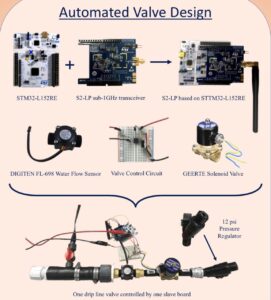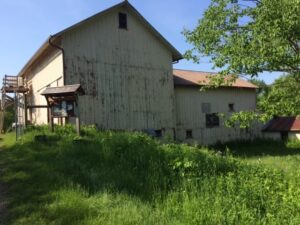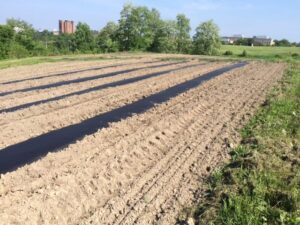As part of our preparation for the ST Developers Conference 2018, we launched a new series on the blog entitled ST Technologies in Universities. We started with a course by Professor Zhu on STM32 embedded systems in an assembly language that showed how this low-level paradigm could be the secret weapon of engineers working on Machine Learning. Today, we want to focus on an automated irrigation system by students graduating from the School of Electrical and Computer Engineering at Cornell University. Similar to the SensorTile capstone projects under the supervision of Professor William Kaiser at UCLA, this smart irrigation system, under the guidance of Professor Joseph Skovira, aims at giving future professionals the experience and knowledge to tackle tomorrow’s challenges. We would also like to commend Boyi Xu and Brian Gross, both Master of Engineering students, who led the efforts on this groundbreaking (pun intended) smart irrigation system.
According to the World Bank, Climate-Smart Agriculture (CSA) is “an integrated approach to managing landscapes — cropland, livestock, forests, and fisheries – that address the interlinked challenges of food security and climate change.” By 2050, the world will need to produce 70 % more food to sustain the 9 billion people that will be living on our planet, but it will demand a “major shift in the way water, soil, nutrients, and other agricultural resources are managed,” according to the International Atomic Energy Agency. Leading universities, like Cornell, thus take it upon themselves to prepare their students to understand and create the technologies that will better manage these resources to shape the societies of tomorrow.
To Cornell and Beyond!

At first glance, the design is deceptively simple, but a deeper dive reveals its ingenuity. A master device sends commands to one or more slave devices that each control a drip line valve along the irrigation system. This network can thus automatically start watering a field at a particular time, detect and report leaks, or quickly integrate new valves into the network to facilitate the expansion of the irrigation system. Both master and slaves are using a NUCLEO-L152RE as a base and the STEVAL-FKI915V1 expansion board, which includes an S2-LP module to take advantage of the Sigfox network. This stack is then connected to an external valve control circuit, a solenoid valve, and a water flow sensor.
Hence, the first prowess of this project resides in its tremendous cost-effectiveness. Irrigation systems tend to be extremely expensive, with some models costing $100,000. However, by using ST products, students were able to conceive a much more affordable device that costs less than $100 per unit, to potentially reach small and medium farms. The second significant advantage is its small size, which makes it reasonably easy to deploy and manage. Slaves can run on batteries in the field, and small enclosures can protect them from the elements, making the whole installation a lot more practical, especially for farmers with more modest investments in technologies. This is probably one of the most underrated aspects of the project as its ease of deployment opens the door to great applications in developing countries that need CSA to reduce waste and drastically increase efficiency.
The Beginnings of the Automated Irrigation System
When talking about the genesis of the automated irrigation capstone project, Professor Skovira explained that:
“Very early on, the Nucleo and STEVAL products were a good fit for what we were trying to accomplish and we [the people participating in this project] want to thank ST for sending us devices that helped us get started and see what was possible. We also began by simply using a basic radio technology available with the ST expansion boards to establish a peer-to-peer network, and are now expanding that system to use the Sigfox network as we start installing these prototypes in the field.”

Cornell’s students quickly used the radio by experimenting with the STSW-S2LP-DK, a development kit offering a Graphical User Interface to increase the accessibility of the S2-LP module present on the STEVAL-FKI915V1 expansion board. Using the application examples of this development kit also facilitated the creation of a simple network to get a taste of the hardware capabilities.
Students started using the source code of the example application, then built upon it to fit their needs. For instance, they used STM32CubeMX to configure the microcontroller of the NUCLEO-L152RE to initialize additional functions and go beyond the original feature-set. They also used the debugger present on the Nucleo board to check the registers and more quickly find bugs, which helped them sort out some of the issues that rose as they built on the code.
Sigfox: Let the Data and Water Flow

Professor Joseph Skovira also delved deeper into the decision to use the Sigfox Low Power Wide Area Network (LPWAN) to connect the master and slave devices. The school had used a custom sub-gigahertz network for other projects and the students knew they had multiple options, but the excellent relationship between Sigfox and ST pushed them to take advantage of this ecosystem.
This level of integration also kept costs down, which was an important goal for a project that tries to popularize Climate-Smart Agriculture. Additionally, using Sigfox accelerated developments. For instance, the school had an S2-LP module with a pre-flashed Sigfox firmware. Furthermore, the security features baked in the network protocol offer the students an essential layer of protection against intrusions.
The school’s experience was also extremely positive. David Baughman, Field Sales Engineer at Sigfox, told us that installing the network was quite simple and accomplished in less than half an hour. Indeed, the master device is currently in the barn of the Dilmun Hill Student Farm. However, the students were afraid that this location might not be good enough because the building sits at the bottom of the hill and the line of sight is suboptimal. Nevertheless, all the devices connected to the network and the bandwidth was excellent, which is a testament to the robustness of the Sigfox network. The next step of the project is now to take advantage of that network to optimize the communication between the master and the slave devices to save resources and demonstrate the reliability as well as the efficacy of this automated irrigation system.
Previously, on ST Technologies in Universities:
